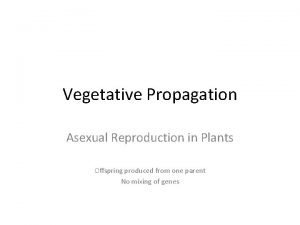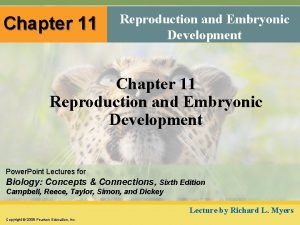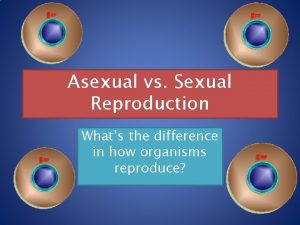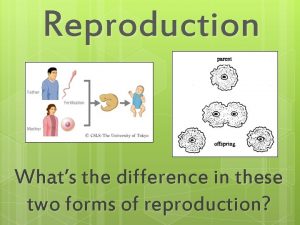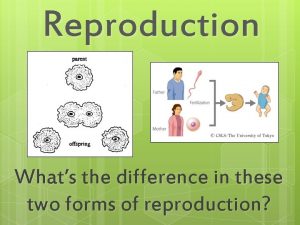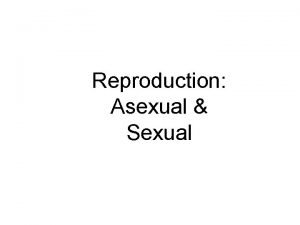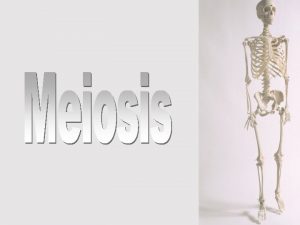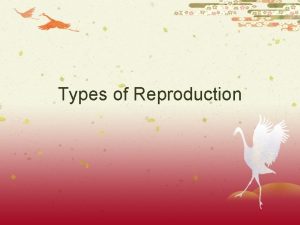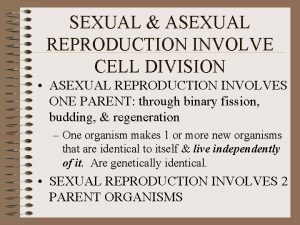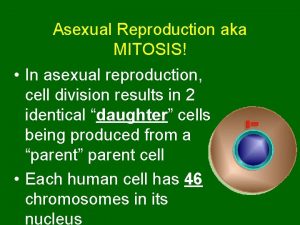Cell Reproduction 1 Types of Cell Reproduction Asexual




















- Slides: 20

Cell Reproduction 1

Types of Cell Reproduction üAsexual reproduction involves a single cell dividing to make 2 new, identical daughter cells üMitosis & binary fission are examples of asexual reproduction üSexual reproduction involves two cells (egg & sperm) joining to make a new cell (zygote) that is NOT identical to the original cells 2

Cell Division in Prokaryotes 3

Cell Division in Prokaryotes ü Prokaryotes such as bacteria divide into 2 Parent cell identical cells by the process of binary fission Chromosome ü Single chromosome doubles makes a copy of itself ü Cell wall forms Cell splits between the chromosomes dividing the cell 2 identical daughter cells 4

Prokaryotic Cell Undergoing Binary Fission 5

Animation of Binary Fission 6

Asexual Reproduction in Eukaryotes Three main types: all result in genetically identical offspring. 1. Budding 2. Fragmentation 3. Vegetative Reproduction 7

Cell Differentiation What makes us so different, but still the same.

What is cell differentiation? • cellular differentiation is the process by which a less specialized cell becomes a more specialized cell type.

Why differentiate cells? • Because the various cells of each plant and animals need to perform different functions! – Differentiation dramatically changes a cell's size, shape, membrane potential, metabolic activity, and responsiveness to signals. – Once an egg cell is fertilized and becomes a zygote, mitosis produces MORE cells and differentiation produces DIFFERENT cells that eventually becomes tissues, organs, etc.

How do cells differentiate? • Cellular differentiation almost never involves a change in the DNA sequence itself. – Thus, different cells can have very different physical characteristics despite having the same genome • These changes are largely due to highly controlled modifications in gene expression: this means that different cells use different genes.

Muscle cells • Muscle cells are designed to contract and relax allowing for movement.

Nerve cells • Nerve cells are designed to receive and transmit impulses from one area to another.

Blood • Blood is responsible for transporting various materials to and from the cells. • It also patrols the body as part of the defense system.

Introducing…. stem cells!

What are stem cells? • the body is made up of about 200 different kinds of specialised cells such as muscle cells, nerve cells, fat cells and skin cells • all cells in the body come from stem cells • a stem cell is a cell that is not yet specialised • the process of specialisation is called differentiation • once the differentiation pathway of a stem cell has been decided, it can no longer become another type of cell on its own

Why are stem cells special? Stem cells can: • self-renew to make more stem cells • differentiate into a specialised cell type Stem cells that can become many types of cells in the body are called pluripotent Stem cells that can become only a few types of cells are called multipotent Embryonic stem cells (pluripotent) Tissue stem cells (multipotent)

Tissue stem cells • often known as adult stem cells • also includes stem cells isolated from fetal and cord blood • reside in most tissues of the body where they are involved in repair and replacement Bone marrow Kidney Lung • generally very difficult to isolate • already used to treat patients (haematological malignancies, diseases of the immune system)

Where do embryonic stem cells come from? • Donated excess IVF embryos egg Day 0 Inner cell mass fertilised egg 2 -cell 8 -cell blastocyst Day 1 Day 2 Day 3 Day 6 Images from www. advancedfertility. com

Embryonic stem cells human embryonic stem cells • derived from donated IVF embryos • can be grown indefinitely in the laboratory in an unspecialised state • retain ability to specialise into many different tissue types – know as pluripotent • can restore function in animal models following transplantation Human embryonic stem cells can become any cell in the body including these beating heart cells
 Sexual reproduction vs asexual reproduction venn diagram
Sexual reproduction vs asexual reproduction venn diagram Hare lynx
Hare lynx Sexual asexual venn diagram
Sexual asexual venn diagram Is mitosis asexual
Is mitosis asexual Types of asexual reproduction
Types of asexual reproduction Examples of asexual propagation
Examples of asexual propagation Types of asexual reproduction
Types of asexual reproduction Type of sexual reproduction
Type of sexual reproduction Dahlia asexual reproduction
Dahlia asexual reproduction Asexual reproduction of flatworm
Asexual reproduction of flatworm Budding asexual reproduction
Budding asexual reproduction Asexual propagation layering
Asexual propagation layering Asexual reproduction
Asexual reproduction Asexual reproduction
Asexual reproduction Whats asexual reproduction
Whats asexual reproduction Sexual reproduction organisms
Sexual reproduction organisms Chapter 19 asexual reproduction answer key
Chapter 19 asexual reproduction answer key Difference of sexual and asexual reproduction
Difference of sexual and asexual reproduction Whats sexual reproduction
Whats sexual reproduction Whats asexual reproduction
Whats asexual reproduction Advantages of genetic diversity
Advantages of genetic diversity








